 |
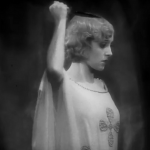 |
 |
| Legendre … Bela Lugosi |
Madeline Parker … Madge Bellamy |
Neil Parker … John Harron |
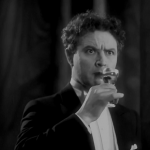 |
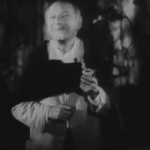 |
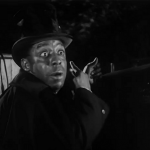 |
| Charles Beaumont … Robert Frazer |
Dr. Bruner … Joseph Cawthorn |
Coach Driver … Clarence Muse |
Proof That It’s Pre-Code
- A hypnotized woman is the plaything of devious men, who use the living dead to exact terror upon each other!
- We also get a scene of that woman trying on her wedding lingerie, for those of you who are unsure what they’re wearing under that big ol’ dress.
- Good old racism rears its head. Our hero notes about his zombie girlfriend: “Surely you don’t think she’s alive in the hands of natives? Oh, no. Better dead than that!”
White Zombie: The Revenge of the Living Dead
“If nature could play pranks like that, why isn’t it possible to play pranks on nature?”
Bela Lugosi’s eyes haunt White Zombie. Deep, expressive, focused. It doesn’t hurt that they’re attached to the rest of Bela Lugosi, but it’s that magnificent stare straight through the camera and into the audience that creates a lasting impression.
His eyes are one of the major components to the atmosphere of White Zombie, a pre-Code horror film drenched in mood. The horde of the undead here are not flesh eaters but simply those who have lost the ability to think and feel, the result of voodoo, hypnotism, and Lugosi’s ghoulish eyes.
Our story begins with a cute, idealistic couple who’ve traveled to Haiti by boat planning to be married. Madeline is a big eyed doll-faced kind of woman, and Neil is here sweet if dull kind of man. They’ve been invited by Msr. Beaumont to his lavish mansion, offering to give Neil a job if they marry there– but more to the point he’s hoping he can talk Madeline out of marrying Neil so that she will marry him, and he’s willing to sink to any means necessary to do so.
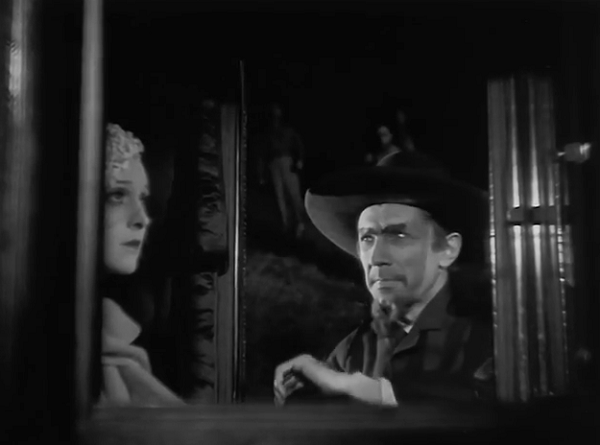
“Hey, baby, where ya gotta go?”
On the ride in, however, they pass a group of people digging a grave in the middle of the road– a place where the diggers know it will be difficult to rob of its contents. They also are stopped by a man with a nasty smile and the worst glint in his eye. That’s ‘Murder’ Legendre, Lugosi’s character. Given the way he stares and steals Madeline’s scarf– almost strangling her in the process– you can tell he’s trouble.
Legendre is what is commonly referred to as ‘a piece of work’. He has a zombie posse that follows him around, from the witch doctor who he tortured his methods out of to politicians, policemen, and rich enemies who dared cross his path. He clearly gets an erotic thrill from using his power and based on the looks he’s giving Madeline, it’s clear he wants to expunge some of those unto her.
Neil and Madeline make it to Beaumont’s mansion a bit shaken up but make themselves at home. They’re very much in love, much to Beaumont’s chagrin, so their host slinks off to arrange with Legendre the process of faking Madeline’s death and turning her into a zombie– Beaumont’s zombie.
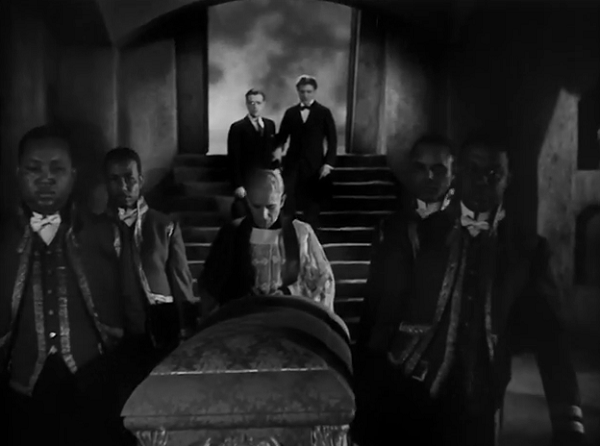
Well, that’s…. creepy.
This nearly-literal deal with the devil goes south pretty quickly, as Beaumont finds that working with a dude nicknamed ‘Murder’ is a poor decision. A local missionary, Dr. Bruner, and Neil team up to go find Madeline and put an end to Legendre’s reign.
Neil’s own impotent attempts at saving the day are pretty pathetic– his actions come more from The Perils of Pauline than as any machismo spewing leading man. He’s a weak, obsessed drunkard who faints at the drop of the hat. This figures heavily into the climax, which involves the main problem with dumb unthinking creatures– you really can’t trust them to carry out dirty deeds without some help.
The film’s look is that of creeping dream imagery, something not too far removed from Castle of Doom a few weeks back. Legendre’s own castle merges with the nearby cliffs, towering over all who approach. Often times director Victor Halperin uses shadows against the wall to haunt the characters, leaving them alone in the scene with only hands creeping towards them silently, slowly. Other times he makes use of a shrieking vulture who haunts Legendre’s victims and screams in a high-pitched human voice at the most inopportune moments.
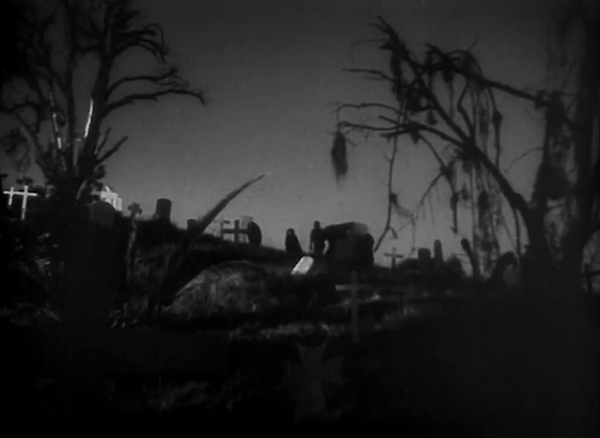
“Yes, excuse me. Have you seen Death around here? We’re supposed to meet up for a chess match.”
The most notable thing, though, is that like Lugosi’s later picture, The Black Cat, White Zombie features a great deal of background music. Haunting chants follow our characters through Haiti’s plantations and endless nights, and dirges accompany the villain’s calculated machinations. It’s an excellent use of classical scores and original music, too, and elevates the film above many of its contemporaries that were using long stretches of silence over their scenes of dread.
Modern day zombie films often have their own subtexts. From Night of the Living Dead we get a satire on lynch mob mentality and racial politics. Dawn of the Dead is a poke at consumer culture; the zombies there infested a mall, and our small band of humans hurried to empty the buildings of the undead so that they could capture their own capitalist utopia.
White Zombie‘s points don’t land too far from this, though the vicarious thrill from violence that comes in later zombie pictures is certainly absent. It’s more concerned with illustrating Legrande as the ultimate Gothic plantation owner, a man whose conquered both his opposition and found a way not just to work his slaves to death, but beyond even that. His greed knows no bounds, but he is still a mannered monster.
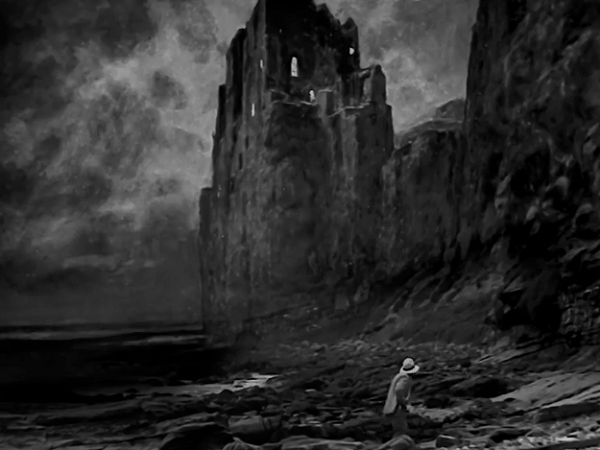
Looks like things are about to get rocky…
The film’s creepiest moments come from Legendre’s betrayal of Beaumont, which involves a mickey of a minor amount of zombie toxin. Earlier, when seeing Legendre’s sugar mill filled with the laboring dead, Beamont had been so disturbed that he’d refused to shake Legendre’s hand. Now that slight has been returned, with Beaumont slowly transforming into an unthinking creature. Legendre doesn’t brag but takes fascination in the change. Worse, he forgives Beaumont with a nasty little laugh. “We understand each other better now.”
Lugosi’s carnivorous portrayal of Legendre and the films queasy line between spiritualism and death make it a haunting piece of work. The film has no definite rules, no respite from the broken natural state that Legendre flaunts with a suave pleasure. This makes the White Zombie‘s journey into the darkness an experience that is simply unshakeable.
Trivia & Links
- White Zombie was recently released on blu-ray from Kino, and the reviews are notably mixed. It sounds like the default transfer on the disc has been turned into a waxy nightmare, while there’s a ‘raw’ version as a special feature that looks a lot more like the film’s intended presentation. There’s also an interview with Lugosi from back in the day and a commentary track. Here are the reports from DVD Beaver, DVD Talk (and here’s the two versions compared), and Blu-ray.com.
- Have you ever read a review and started pointing at the screen and shouting, “Yes, exactly!”? And You Call Yourself A Scientist nails every aspect of the film and provides some excellent screenshots and quotes. Definitely check it out.
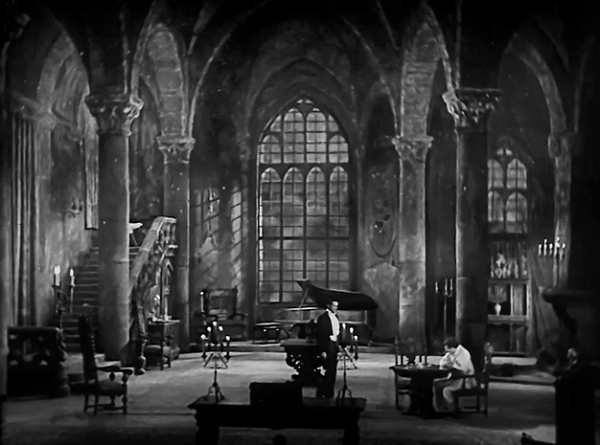
This room needs a plant. Yeah.
- TCMDB has a good amount of details on the making of this film. Here’s their rundown on how such a cheaply made film looked so elaborate:
The film was shot on the RKO-Pathe lot in Culver City and at Universal City. One of the sets from Cecil B. DeMille’s epic, The King of Kings (1927), was used for Legendre’s mountaintop veranda and castle interiors were assembled from parts of the Dracula and Frankenstein sets. The creepy zombie makeup was devised by Carl Axcelle and Jack Pierce of Universal who transformed Boris Karloff into The Mummy (1933) and other famous monsters. Another unique contribution was the innovative use of music arranged by silent picture maestro Abe Meyer. Some terrifically weird effects are achieved using native drumming, chants, and natural sounds. Even a Spanish jota composed by Xavier Cugat is used for one haunting sequence where John Harron (Neil Parker) pursues an apparition that looks like his bride.
- The ever wonderful Greenbriar Picture Show picks up from there and takes on the film’s afterlife, from its successful run in theaters to its television appearances and notoriety over the years.
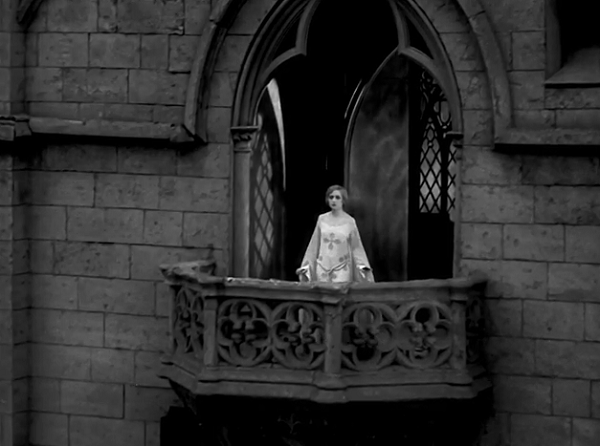
“Oh Romeo, oh Romeo, get me the hell out of here.”
- This film is a rarity around these parts, as it was an independent production by a couple of maverick filmmakers. There are rumors that Lugosi only took $800 for the film’s 11-day shooting schedule, and that he may have directed several scenes himself.
- Being both in the public domain and a cult movie, there’s a lot written on this out there. If you want more, I suggest looking up White Zombie over at Classic Movie Search.
Awards, Accolades & Availability
- This film is in the public domain, so there are plenty of copies floating around. Like, oh, here. The restored blu-ray is available on Amazon and can be rented from Classicflix.
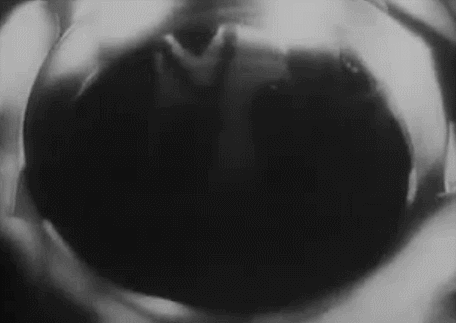 |
Comment below or join our email subscription list on the sidebar!Home | All of Our Reviews | What is Pre-Code? About the Site | Follow @PreCodeDotCom |
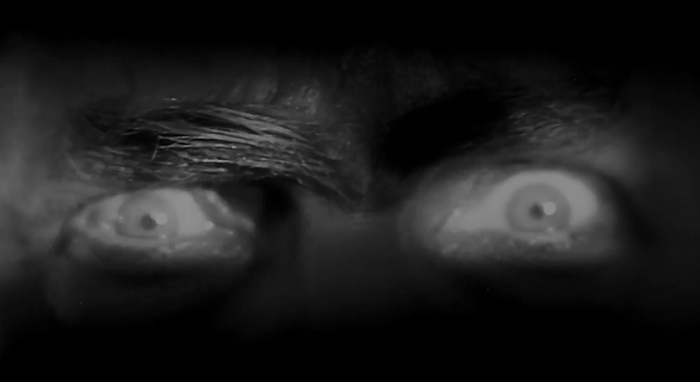



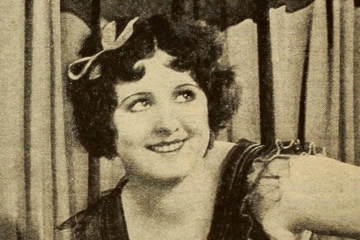
6 Comments
brianpaige · October 20, 2013 at 8:29 pm
This is one of my all time favorite Lugosi flicks. I bet I’ve tracked down various versions and all that over the years. In the cold light of day the hero and heroine are both completely terrible and there are some unintentional yuks. But the atmosphere itself and Lugosi….oh man. The tops.
Danny · October 20, 2013 at 8:43 pm
Definitely. I don’t think most horror heroes come out looking very good, and this one is no different, but the sheer reflections of evil pleasures in Legendre’s eyes is aces.
Glen Forrester · May 9, 2014 at 4:33 am
I agree with your review and this is one of my favorite Lugosi films. The b/w cinematography is stunning with its use of lighting. Also I’d like to point out that in my opinion the film is a critique of capitalism as well. The ‘workers’ in Legendre’s sugar mill are unthinking automatons. Not only their labor, but their very souls, have been commodified!
Danny · May 10, 2014 at 9:57 pm
It’s gorgeous for sure, and I agree, it’s definitely a comment on capitalism you definitely wouldn’t see from the major studios at the time.
Jan Ostrom · June 28, 2017 at 1:29 pm
In one scene as the zombies walk straight ahead with glassy eyes and fall off the pier, One of the zombies holds his nose.☺️
Comments are closed.